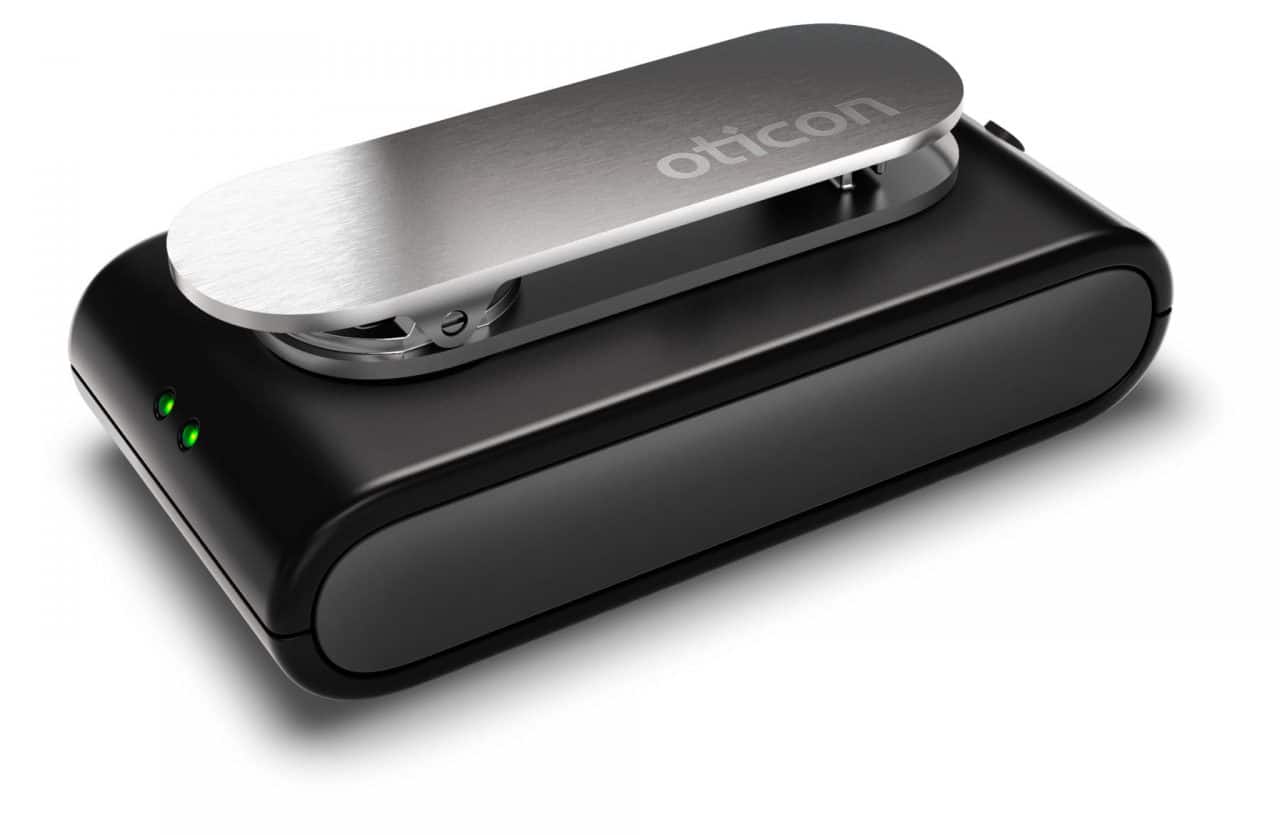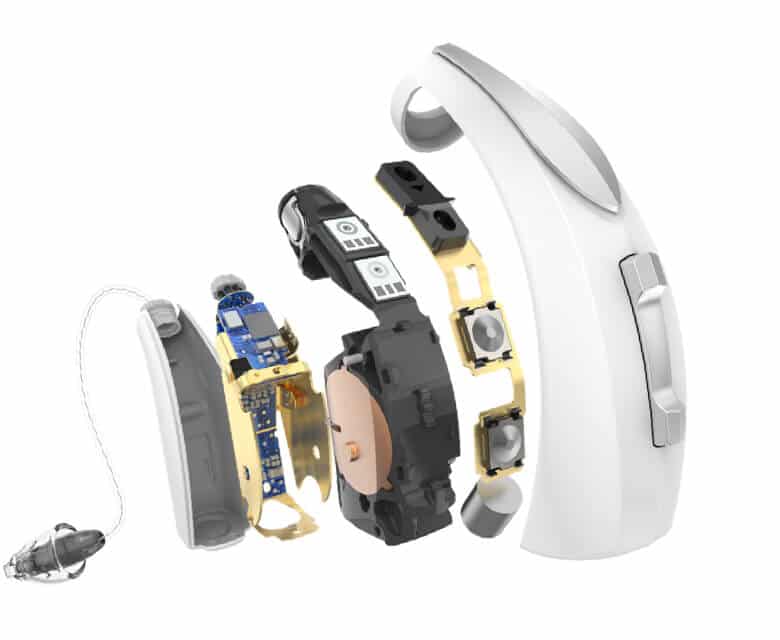Hearing aids alone can be fantastic…but for some, hearing aids alone do not accomplish all of their goals. For this reason, accessories are available which work with the hearing aids for specific uses such as TV, landline and cell phone, distance listening, larger groups, etc.
We will help you identify any additional needs during your Functional Hearing Assessment and throughout your journey to better hearing.
Hearing Aid Accessory Options
Some of the more popular hearing aid accessories include:
TV Streaming
If TV is a large part of your life, you may benefit from a direct TV listening experience. This removes distance from the hearing equation. TV streamers exist that plug directly into your TV and send the signal either directly to your hearing aids or through a streamer accessory that you wear around your neck depending on the make and model.
Remote Microphone

For some individuals and for some situations, speech in the presence of background noise continues to be problematic even with hearing aids. Nothing can overcome noise better than a direct signal from the person talking to the person listening. A remote microphone is worn by a patient’s spouse or other communication partner and their voice is wirelessly sent to either the hearing aids or a streaming device worn by the patient. The input reaches over 30 feet helping to improve communication in a restaurant, car, speaking engagement, cooking in the kitchen, etc.
Bluetooth Streamers
Streamers connect to a cell phone via bluetooth. This allows for phone calls and music to stream directly to the patient’s hearing aids. Some streamers also act as remote controls and connect to the TV programs. Some hearing aid models do not need a streamer and can connect to the hearing aids directly.
Remote Controls
Made for smartphone hearing aids have apps that act as remote controls. For individuals that want a more simpler solution, a remote control can be used to change volume or programs, as needed.
Dryers
For individuals that lead active lifestyles and sweat while wearing their hearing aids or work in environments with excessive moisture, a dryer is recommended. Simple dryers with desiccant beads are available but require replacement and reactivation of the beads. Electric dryers are now available that do not require replacement parts. They not only remove moisture from the hearing aids but have a light that kills bacteria. This helps protect and maintain your hearing aids.
EarGear
To help protect from moisture or loss, sleeve-type items are available. They are placed on your hearing aids while working around dirt or moisture of when you are concerned about loss (i.e. boating). They come in a variety of colors and sizes and protect your investment.
Cleaning Supplies
It is important to clean your hearing aids everyday to prevent build-up of debris and earwax. We will teach you how to clean your devices and provide you with an initial supply of cleaning items.
Captioned Phones
These phones are FREE to anyone in the US that has hearing loss. Once you are diagnosed, we can complete a form certifying that a patient has hearing loss and complete a referral to get a free captioned phone. You hear the phone call at the same time you see the words on the screen. There are different styles and options depending on your home phone situation and internet capability.
Alerting Devices
Alerting devices hook up to telephones, alarm clocks, doorbells and other electronic devices. They alert you through a loud sound or flashing light, making you aware of an incoming phone call, a visitor at the door, etc.
Batteries

Most hearing aids use disposable zinc-air batteries that are color- and number-coded for easy replacement. The type of battery needed depends on the style and size of your hearing aids and includes: 5 (red), 10 (yellow), 13 (orange), 312 (brown) and 675 (blue). Battery life varies depending on the size and style of your hearing aids, your degree of hearing loss, the amount of time your hearing aids are used, your listening environment and if you stream media.
Most drugstores carry replacement batteries; they can also be purchased from your audiologist at Elevate Audiology or ordered online.
Rechargeable Batteries
Rechargeable hearing aids are one of the top most requested features that hearing aid users are asking for. They free users from having to deal with the tiresome task of changing the batteries, performing daily battery tests and always carrying around extra batteries. Rechargeable batteries are also environmentally friendly as they save users from throwing away nearly 100 hearing aid batteries per year.
The benefits of rechargeable batteries are plentiful:
- Your charger can be your devices’ overnight home so you don’t have to worry about losing them.
- You don’t need to worry about having extra batteries on hand.
- You will save time and money by not having to purchase disposable batteries.
Many rechargeable batteries can provide up to 24 hours of hearing from a single charge. The hearing aid may also include a fast-charging option, which gives uses a few hours of immediate use.
Assistive Listening Devices
Assistive listening devices (ALDs) are portable systems that help individuals with hearing loss communicate more effectively. Unlike hearing aids, which amplify sounds, ALDs work by separating speech from background noise. This allows the person with the hearing impairment to hear more clearly.
Some ALDs are used in conjunction with hearing aids, while others work as standalone devices. ALDs are useful in a number of situations, primarily those involving distance, poor acoustics and noisy backgrounds.
There are several different types of ALDs available, for both large facilities and personal use. Some focus on amplifying speech, while others utilize computer programs to convert text to speech. Some of the different types include:
FM Systems
FM systems rely on radio signals to transmit amplified sounds directly to your hearing aid. They consist of a microphone, transmitter and receiver, and are used in a variety of public places such as classrooms, restaurants, movie theaters and churches.
The microphone is worn by the person speaking (or placed in close proximity to the sound source) and the signal is broadcast from the transmitter to the receiver, which is tuned to a specific frequency.
Personal Amplifiers
Personal amplifiers are essentially small FM systems used in smaller, more intimate settings where radio signals are less effective; they are often used when watching television, traveling by car or spending time outdoors.
The microphone is built directly into the unit, and is often directional, allowing you to aim it in the direction of the sound source in order to pick up the signal most effectively.
Infrared Systems
Infrared systems work on the same principle as FM systems, but use infrared light instead of radio waves to transmit sound. The transmitter converts sound signals into light and beams those to the receiver, which then translates the light signal back into sound.
An advantage to infrared systems is the fact that their signal is unable to pass through walls as it does with FM systems, eliminating competing broadcasts that might hamper the listener and preventing confidential information from being disseminated. They are particularly useful in courtrooms and large movie theaters.
Hearing Loops
Hearing loop, or induction loop, systems utilize electromagnetic energy to transmit sound directly to your hearing aid or cochlear implant. They consist of a sound source (public address systems are popular), an amplifier, a loop of wire and a receiver or telecoil (t-coil), a tiny wireless receiver built into many devices.
When you are in close proximity to the loop, you will receive clear sound free of background noise. Hearing loops can be connected to all types of audio sources, and are often set up in public facilities such as airports, churches and lecture halls.
Call Elevate Audiology at (864) 442-5555 for more information or to schedule an appointment.
